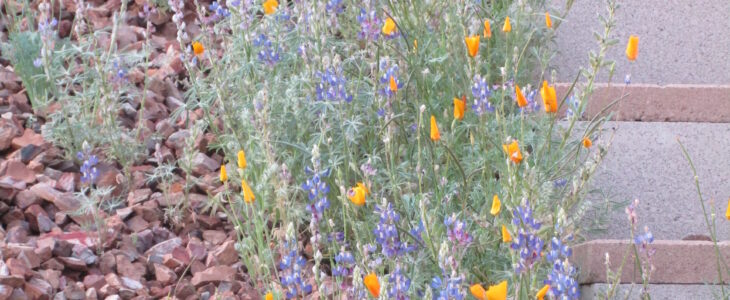
Wildflowers spread wonderfully in my backyard this spring. My foot also suffered an injury mid-March. So I was especially thankful for the show of color and natural beauty I could enjoy at home in lieu of hiking more wild spaces.
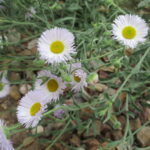
What makes a flower wild? When I searched online, Cambridge Dictionary provided the least circular definition of wildflower, as “any flower that grows without having been planted by people.”
Are you a gardener who scattered a mix of native seeds in October in anticipation of March blooms? Do you purchase flowering plants that thrive on seasonal rainfall so you can conserve potable water? I propose “any flower that CAN grow without having been planted by people”. We do intercept some seeds, just as some seeds later get away. Let’s explore my current backyard blooms by playing with some more plant words.
On-purpose, on-their-own, or both!
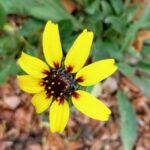
Purple Lupine, golden California poppy, white snapdragons, yellow chocolate flower, and blue rosemary are currently blooming, and at some point I planted them on purpose (See lupines and poppies in title image, taken myself.). In contrast, the yellow fiddleneck and London rocket, and the pale purple fumaria and fleabane, found their way here 100% on their own. Call them “volunteers” or call them “weeds”, but I didn’t plant the seeds.
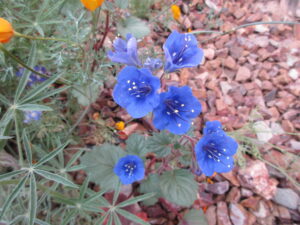
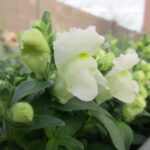
A lot of flowers in my yard have on-purpose ancestors but now re-seed themselves, or volunteer, each year since. The lupines are a mix of descendants whose story started before I got married, and of supplemental seed my husband or I add every few years. The poppies are also a mix of old and new. My son planted all of this year’s backyard snapdragons from nursery stock in Fall 2022. However, some years I spot on-their-own snapdragons that grow where a parent plant grew the year before. Indigo-colored Bluebells have established a wild population that began after I brought home a pot of them from Kid 1’s 1st grade classroom. That kid is now in middle school.
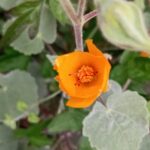
And the magenta penstemon, orange Indian mallow, yellow brittlebush, and orange and pink globemallow? For each of these plants, the population consists of both new-this-year individuals and older parents originally seeded or transplanted by myself or my family. Because of the ease with which all of the above plants grow with or without my help, I call them wild.
Annual and perennial
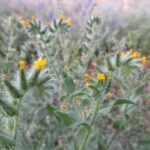
Wildflowers are a seasonal phenomenon: bluebells, lupines, and poppies as well as fiddlenecks and London rocket are well-known to germinate with Southern Arizona’s winter rains and produce flowers in the early spring. Then they produce seeds, dry up, and die. That growth pattern makes them cool season “annuals”.
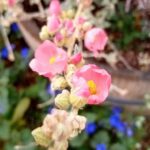
Other showy spring plants do make flowers in March – but grow for two or more years, so they are “perennials”. Globemallow and brittlebush are massive examples of perennials in my yard and along 1-10 right now. Similarly, penstemon send up a stunning pink flower stalk as the weather warms, always a fun surprise even though I know it’s coming. Indian mallow get big and actually bloom most of the year. Of smaller stature are the pockets of fleabane daisy and chocolate flower, both of which survive year-round but now get to bloom again. Pick up a field guide or take a desert drive to find examples of both annual and perennial wildflowers.
Native and non-native
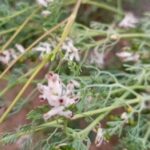
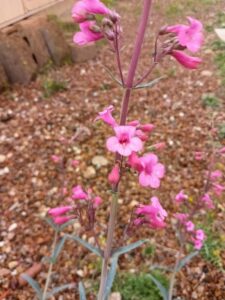
Native plants, according to the US Department of Agriculture, “…have evolved and occur naturally in a particular region, ecosystem, and habitat. Species native to North America are generally recognized as those occurring on the continent prior to European settlement.” Fiddleneck is cheerful to look at and painful to pick, especially after it dries out in late spring. But it’s an Arizona native. In a wild desert landscape, this flower belongs. The fleabane daisies that take over parts of my yard but are soft to the touch, are also native. So is fumaria, whose leaves tricked me into thinking they were poppies or stray carrots, but whose mature form is its own pretty thing. The bluebell, lupine, poppy, penstemon, chocolate flower, brittlebush, Indian mallow, and globemallow populations in my yard are native. They like extra water from my hose, but they survive on seasonal and low rainfall. I deem them wild.
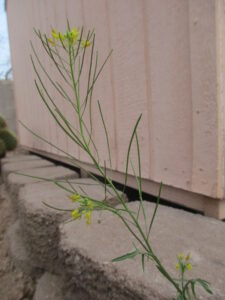
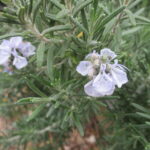
Some other plants are also adapted to our desert – but they are non-native, introduced from Europe or the Mediterranean. London rocket, an edible mustard, plants itself – I consider it wild. Snapdragons grow well with watering and only sometimes become wild. The rosemary bush that I added three years ago, added pale blue blooms to my yard this year. It is the least wild of my current non-native flowers, because it stays contained in its bed – but still made me smile from surprise.
Weed and welcome
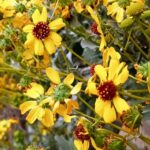
By my own wording, a weed is “a plant growing where you don’t want it to grow”. If it spreads on its own, and it makes a flower, call it a wildflower. The wildflowers that I personally deem weeds in my backyard are: Fiddleneck because of its painful prickles, London rocket because it’s non-native, and brittlebush because it both spreads and gets big. I pull them when I get around to it, enough to keep them in check but not gone. In fact, several brittlebush bushes stay as gorgeous accent plants.
Everything else described earlier is welcome in my backyard if it’s not directly in the way. I want flowers to grow, and importantly I don’t want to do much work to grow them. I both add and allow wildflowers. I welcome the diversity of colors that come each spring.

